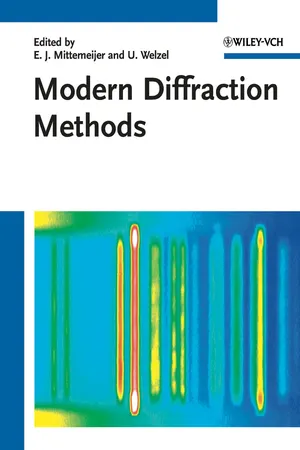![]()
Part I
Structure Determination
![]()
Chapter 1
Structure Determination of Single Crystals
Sander van Smaalen
1.1 Introduction
Many crystalline materials possess translational symmetry. This property implies that the positions of the atoms can be obtained from the positions of a few atoms in a small volume (the unit cell), which is periodically repeated in space. Thus, the crystal structure is completely characterized by the translational symmetry — as given by the six lattice parameters — together with the positions of the atoms within one unit cell (Figure 1.1a) [1]. The goal of the procedure of structure determination is to obtain the atomic positions in the unit cell and the lattice parameters from a diffraction experiment.
X-rays are scattered by matter (Figure 1.1b). A consequence of translational symmetry is that scattered rays are only obtained for directions k corresponding to scattering angles 2θ as followed from Bragg's law. Furthermore, each Bragg reflection requires a specific orientation of the crystal with respect to the directions of the primary and scattered X-ray beams. Both properties depend on the lattice parameters, while different Bragg reflections are distinguished on the basis of a unique indexing with three integral numbers (h k l). The other way around, knowledge of the orientations of the crystal in conjunction with the directions of the diffracted beams for a sufficiently large number of Bragg reflections allows the determination of the lattice parameters and the indices of each Bragg reflection.
The amplitude and phase of the diffracted beam are the second unique property of each Bragg reflection. Their values depend on the structure of one unit cell of the crystal and the indices (h k l) of the Bragg reflection. Knowledge of the amplitudes and phases of many Bragg reflections allow the determination of the positions of the atoms in the crystal by the simple computational procedure of Fourier transform (Section 1.2).
The diffraction experiment provides for each Bragg reflection the orientation of the single crystal and the direction and intensity of the diffracted beam. This information is sufficient to compute the lattice parameters of the crystal and the indices of the Bragg reflections, but it does not allow computation of the crystal structure by the method of Fourier transform. The reason is that the intensity of an X-ray beam is proportional to the square of the amplitude of this electromagnetic wave, while it does not contain information about the phase. This is the crystallographic phase problem. Methods of structure solution aim at finding the crystal structure on the basis of the measured intensities Iobs(h, k, l) of the Bragg reflections. Solving the crystal structure implies solving the phase problem, as the phases of the Bragg reflections can be computed from the structure model and the structure model is obtained by Fourier transform of the Bragg reflections, if both amplitudes and phases of the Bragg reflections are known.
Methods of structure solution depend on a few fundamental properties of matter, which is introduced in Section 1.3. Furthermore, the methods of structure solution discussed in this chapter require the availability of the diffracted intensities of a sufficient number of Bragg reflections, as they can be measured, for example, by single-crystal X-ray diffraction. On the other hand, diffraction by microcrystalline powders results in diffracted intensity as a function of the scattering angle 2θ. Different Bragg reflections with equal or nearly equal scattering angles cannot be resolved, with the consequence that intensities of individual Bragg reflections cannot be obtained by powder diffraction for at least part of the reflections. Methods of structure solution have been developed, which account for the peculiarities of powder diffraction; these are discussed in Chapter 2.
Twinning is another feature, which prevents the measurement of intensities of individual Bragg reflections. Instead, apparent Bragg reflections of a twinned crystal may be the sum of two or more different reflections. For formal reasons, the methods of structure solution discussed in this chapter do not apply to this kind of diffraction data. Nevertheless, they may often give the correct solution (e.g., for inversion twins of a noncentrosymmetric crystal) or may lead to some average structure, which then provides the essential clue for the construction of the true structure model. However, twinning may also prohibit structure solution. Special problems and solutions related to twinning are not discussed in this chapter.
Apart from the crystal structure, intensities of Bragg reflections depend on a series of other effects, such as the geometry of the diffraction experiment, the polarization of the radiation, and absorption of X-rays by the sample. Different reflections may require different correction factors accounting for these effects, but these can be computed without knowledge of the crystal structure. It is understood that Iobs(h, k, l) has been obtained from the real measured intensity values by the application of these correction factors. Other, trivial dependencies are the proportionality of intensities of Bragg reflections to the intensity of the primary beam, to the volume of the crystal, and to the time of the measurement. Factors such as these affect all Bragg reflections in the same way, and they go into the scale factor (Section 1.5).
This chapter concentrates on structure determination by single-crystal X-ray diffraction. However, the same or similar methods can also be successful when applied to neutron diffraction or electron diffraction data.
1.2 The Electron Density
The elastic scattering of X-rays is determined by the electron density distribution in space. The periodicity of crystal structures determines that scattering is concentrated in directions represented by scattering vectors equal to lattice vectors of the reciprocal lattice of the crystal,
The integers (h k l) are used for indexing of the Bragg reflections. Non-Bragg scattering is experimentally eliminated by subtracting a background measured close to each Bragg reflection from the measured Bragg intensity, eventually leading to Iobs(h, k, l) (Section 1.1).
The amplitudes and phases of the scattered waves of the Bragg reflections are given by the Fourier coefficients of the...


